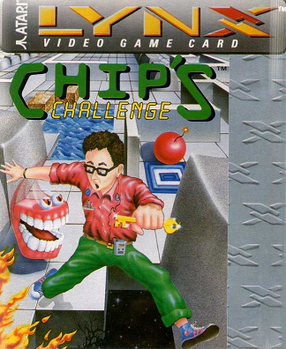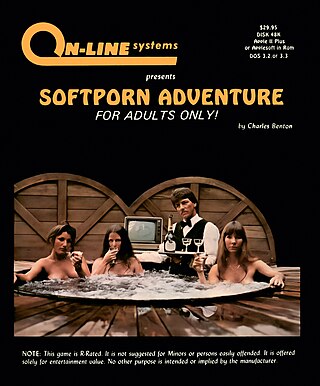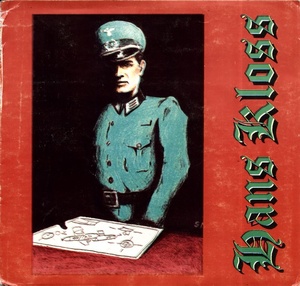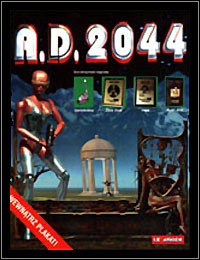
Adventure is a video game developed by Warren Robinett for the Atari Video Computer System and released in 1980 by Atari, Inc. The player controls a square avatar whose quest is to explore an open-ended environment to find a magical chalice and return it to the golden castle. The game world is populated by roaming enemies: three dragons that can eat the avatar and a bat that randomly steals and hides items around the game world. Adventure introduced new elements to console games, including enemies that continue to move when offscreen.

Chip's Challenge is a top-down tile-based puzzle video game originally published in 1989 by Epyx as a launch title for the Atari Lynx. It was later ported to several other systems and was included in the Windows 3.1 bundle Microsoft Entertainment Pack 4 (1992), and the Windows version of the Best of Microsoft Entertainment Pack (1995), where it found a much larger audience.
Dynamix, Inc. was an American developer of video games from 1984 to 2001, best known for the flight simulator Red Baron, the puzzle game The Incredible Machine, the Front Page Sports series, Betrayal at Krondor, and the online multiplayer game Tribes.

Jazz Jackrabbit 2 is a 1998 platform game produced by Epic MegaGames. It was released for Windows, and later for Macintosh. Like the first game, Jazz Jackrabbit, Jazz Jackrabbit 2 is a side-scrolling platform game but features additional multiplayer options, including the ability to play over a LAN or the Internet. The game was re-released on GOG.com along with the first game on November 30, 2017.

Softporn Adventure is a comedic, adult-oriented text adventure game produced for the Apple II in 1981. The game was created by Charles Benton and released by On-Line Systems, later renamed Sierra On-Line. Years later, Softporn Adventure was remade and expanded as Leisure Suit Larry series of adult-oriented video games, and the first entry in that series, 1987's Leisure Suit Larry in the Land of the Lounge Lizards, was a nearly direct graphical adaptation of Softporn Adventure. Another graphical version was released as Las Vegas for various Japanese computers in 1986 by Starcraft.
Detalion S.C, was a Polish video game developer founded by a partnership of six people, that first met in the early 1990s, working from game developer and publisher LK Avalon.

The Guild of Thieves is an interactive fiction game by Magnetic Scrolls first published by Rainbird in 1987. The game takes place in Kerovnia, the setting of the company's earlier The Pawn.

Curse of Enchantia is a graphic adventure game developed and released by the British video game company Core Design for MS-DOS and the Amiga in 1992. The game tells the comic fantasy story of Brad, a teenage boy from modern Earth who was magically abducted to the world of Enchantia by an evil witch-queen. He needs to escape and find a way back to his own dimension.
Laboratorium Komputerowe Avalon, abbreviated LK Avalon, was a Polish software developer and distributor, with product range encompassing video games, educational software and other applications.

Heartlight is a puzzle video game originally developed by Janusz Pelc for the Atari 8-bit family in 1990. In 1994, an MS-DOS port was published by Epic MegaGames along with two other games by Janusz Pelc in the Epic Puzzle Pack. The shareware version has 20 levels and the full version has 70 levels. In 2006, Maciej Miąsik, co-author of the MS-DOS version, released it under the Creative Commons CC BY-SA 2.5 license as freeware. The source code became available too. In 2020, a web browser remake was released with updated graphics.

Baldies is a 1995 real-time strategy video game developed by Creative Edge Software and originally published by Atari Corporation for the Atari Jaguar CD. It was later ported to the PC, PlayStation, Sega Saturn, and Macintosh. In the game, the player manages a community of Baldies in order to build structures, increase their population, and create weapons to fight against enemies known as Hairies. There are four classes of Baldies and each structure has specific properties to assist the player. Its gameplay combines strategy with simulation and god game elements. Up to four players can participate in a multiplayer mode via local area network (LAN) on PC.

Electro Man, originally distributed in Poland under the title Electro Body, is an MS-DOS platform game developed by the Polish company X LanD Computer Games. It was originally released in Poland by xLand in 1992, and later published by Epic MegaGames in the United States in 1993; apart from the changed title, the Electro Man release contains some changes, such as upgraded graphics. Though initially offered under a shareware license, the game was released as freeware by the developer on June 25, 2006, under the Creative Commons Attribution-ShareAlike 2.5 license. The player controls a cyborg named "Jacek", who must get through all the areas of a space base while destroying enemies.

Hans Kloss is a puzzle-platform game designed by Dariusz Żołna and published in Poland by LK Avalon. It was published in 1992 for Atari 8-bit computers. A Commodore 64 conversion, programmed by Janusz Dąbrowski, was released in 1993. The player controls Hans Kloss, the fictional protagonist of the Polish TV series Stawka większa niż życie, during World War II. He must find plans for a secret weapon in Adolf Hitler's headquarters, the Wolf's Lair.

Tajemnica Statuetki is a Polish-language adventure game developed and published by Metropolis Software House for DOS-based computers in 1993. While it was never released in English, it is known in the English-speaking world as The Mystery of the Statuette. The game was conceived by a team led by Adrian Chmielarz, who used photographs taken in France as static screens within the game. The first title in the adventure game genre that was produced in Poland, its plot revolves around a fictional Interpol agent named John Pollack trying to solve a mystery associated with the thefts of ancient artifacts around the world.

Reah: Face the Unknown, known in North America as simply Reah, is a 1998 first-person puzzle-oriented adventure game with a non-linear plot, described as a Myst-clone. It was developed by Project Two Interactive / Black Friar and published by Detalion and LK Avalon. It was distributed by Erbe in Spain on October 10, 1998. It was published by Project 2 Interactive in the Netherlands, and distributed in the U.S. and Canada by GT Interactive in 1999.

A.D. 2044 is a Polish adventure game by LK Avalon, released September 9, 1996 on Windows.

Empire of the Over-Mind is an interactive fiction game written by Gary Bedrosian and published by Avalon Hill for the Apple II, Atari 8-bit computers, and TRS-80 in 1981. A version with an enhanced display for IBM PC compatibles by Bedrosian was published in 1986.

Sołtys is a Polish point and click adventure game by LK Avalon which was released for MS-DOS on May 23, 1995.

Kajko i Kokosz is a Polish video point-and-click adventure game based on the Kayko and Kokosh comic-book series about the adventures of two Polish warriors, the comedy duo of Kajko and Kokosz. The game was released for Amiga in 1994, for PC MS-DOS in 1995, and for PC Windows in 1998. It was the first of several video-game adaptations of the Kayko and Kokosh comics. The game was described as a commercial success, despite receiving mixed reviews.
















